Nearly three out of four people are likely to purchase food from the comfort of their own home instead of going out. Is this because of the recent Coronavirus (“COVID-19”) pandemic, or is this where the restaurant business is heading permanently? Since March of 2020, restaurants everywhere were subject to restrictions and shut-down orders to help stop the spread of COVID-19. In due course, this resulted in a substantial loss of sales for many restaurants, all the while their overhead costs remained due. Third-party food services, such as Uber Eats, Postmates, and Grubhub, initially began to surface during 2018. They have grown considerably larger during this time and are now an essential part of our economy.
As the pandemic persists, restaurants are required to come up with ways to help mitigate costs to stay in business– which include employee salaries, utilities, rent. Offering food delivery services allows them to do just that! Restaurant personnel could return to work to serve as many customers as possible, but opening up their kitchens came with a different, significant price to pay. According to Business Insider, third-party delivery services charge restaurants commissions on orders at approximately 30%, a sizeable dent in what are already dwindling profits.
This predicament brought rise to ghost restaurants, which are delivery-only. Setting up a solely virtual restaurant does not entail many of the main costs that traditional restaurants must pay, such as server payroll, higher costs for dining in space and higher utility costs. As they already have the kitchen and space for employees to prepare food, most traditional restaurants can manage by adding delivery. However, ghost restaurants have an edge as their only costs would be online charges, including an online menu, an easy-to-use website, and an online ordering and delivery service module. The ordering and delivery systems are especially vital to success, so many restaurant owners rely on trusted third-party food services.
Foreseeably, the only additional costs for ghost restaurants would be new equipment to keep up with trending food demands. According to US Foods, ghost restaurant revenue could hit $1 trillion by 2030.
Third-party food and delivery services have swept the nation, especially during the pandemic, but at a price, as it is not a modest expense for restaurant owners. During these troubling and uncertain times, if restaurants want to stay relevant and continue in business, they must pay large service fees established by the third-party vendors or add their own delivery services. While the pandemic has given rise to ghost restaurants, which showed significantly larger profit margins throughout 2020 because their overhead costs are much less than a typical restaurant, many restaurant owners are changing their model and adapting to compete and stay the course.
Overall, food delivery services have become an important partnership to the restaurant business. The market shift to ghost restaurants can only help the foodservice industry prepare for what is to come. As a best-selling novelist, Ken Follett, once said, “hard work should be rewarded by good food,” so be sure your restaurant is ready and worthy!
Author: Amelia Fetter, CPA
Consumer Products Team.
Consumer Products




